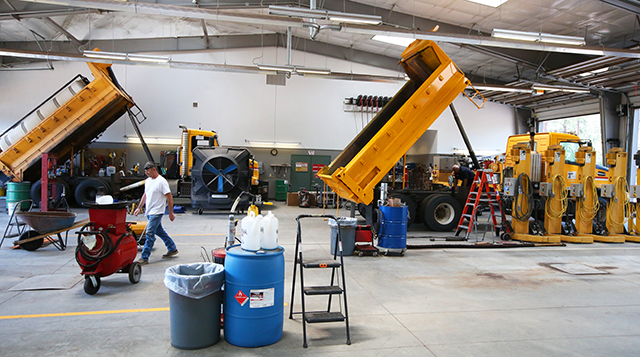1-handed backhand lives on with game’s young stars
Published 12:00 am Monday, July 2, 2018
PARIS — The precise date escapes Stefanos Tsitsipas, but he remembers the moment he left the two-handed backhand behind for good.
“I was very young, like 8 years old, and it was a specific practice session in the afternoon,” he said. “I used to play with a two-hander, and sometimes I would switch to one.
Trending
“And I remember my coach asking me, ‘Stefanos, you have been playing an entire year both ways, are you going to choose?’ And that was the day I switched completely to one. It felt more natural, more beautiful, more dynamic.”
But it was not simply a question of how the shot felt. Roger Federer used a one-hander and still does. So did Pete Sampras, the best men’s player of the 1990s.
“Sampras and Federer, those two guys were the ones I was looking up to and watching on TV when I was young,” Tsitsipas, 19, said when we spoke recently in Paris.
Tsitsipas is now one of those being watched from afar. He is ranked 35th in the world and part of a new wave of players who are ensuring that the one-handed topspin backhand lives on at the highest level. They have emerged despite concern that the shot was having a final moment in the sun with Federer, his Swiss compatriot Stan Wawrinka and Richard Gasquet of France.
Dominic Thiem, 24, just reached the French Open final. Grigor Dimitrov, 27, won the World Tour Finals last year and, like Thiem, has become a fixture in the top 10 even though he has struggled this season.
The two most successful teenagers in the men’s game also use the stroke: Tsitsipas and Denis Shapovalov, 19, a flashy Canadian who is up to No. 26 in the rankings. This is reassuring for tennis aesthetes. The one-hander remains a sweeping thing of beauty, and it connects with the public on a deep level.
Trending
It is partly the novelty of it. Until champions Chris Evert, Bjorn Borg and Jimmy Connors popularized the two-handed backhand in the 1970s, the one-hander was the norm.
But for the spectator, there is also the sense that the one-hander, when driven with topspin, is a triumph over vulnerability. A forehand is usually hit from an open stance in this era, with the nonplaying hand pointing in the direction of the ball. It looks as if there is a sturdier platform behind the stroke, and on the follow-through, the hitting arm generally crosses the body and closes it off (Nadal’s bolo-whip finish is an exception).
But with the backhand and its shoulder turn, there is a void as the ball arrives, and when Federer, Wawrinka, Thiem, Tsitsipas or left-handed Shapovalov rip through a one-hander, their long and high follow-through opens the body in spectacular fashion.
Shapovalov’s one-hander and upper body are so elastic that he flirts with a complete 360-degree arc, from take-back to finish.
“I really don’t think it will die off, and I think it’s great because we don’t want tennis to be boring,” said John Millman, the Australian who lost to Shapovalov in the first round of the French Open. “I think the one thing with the one-handers that they can do, especially on the clay, is generate angles a bit more because they are able to apply a fair bit more topspin and torque on the ball. With the two-hander, you can’t really do that, so it allows the one-hander to pull you off the court a lot more.”
Gunter Bresnik, who coaches Thiem, agrees that the shot will continue to have its place, and he played a primary role in the process by switching Thiem from a two-hander to a one-hander.
Unlike Tsitsipas, Thiem was not given much of a choice. Bresnik began coaching Thiem when he was 9, but he ultimately decided that Thiem’s two-hander was going to prevent him from becoming a great player in the long run by encouraging him to remain too defensive.
“He was 12, and I decided to change it, and for one year, his results went down,” Bresnik said. “He went from like No. 3 in Austria to like 13 or 14, and then he came back the next year and started winning everything.”
Pete Fischer, one of Sampras’ boyhood coaches, persuaded Sampras when he was 14 to abandon his fine two-hander. Fischer’s goal was for Sampras to play more effective attacking tennis: players with one-handed backhands can often make a more seamless move to the net, where backhand volleys are hit with one hand. After struggling to adjust, Sampras went on to win 14 Grand Slam singles titles.
Skeptics could argue that Sampras’ strongest groundstroke was still his forehand, much as it is for Federer, Thiem, Dimitrov and, it appears, for Tsitsipas and Shapovalov. Could they all have been better? A two-handed backhand would have allowed them to produce more consistent power off returns and balls struck above shoulder height and to better compensate on off-center hits.
Perhaps, but tennis is not a beauty contest, even if beauty can certainly help secure sponsorship. The one-hander is surviving in the men’s game because it is an effective option and if there is ever a genuine revival of net play or serve-and-volley play in singles, it could become an even more effective option.
For now, there is no equivalent to Tsitsipas or Shapovalov in the United States, although Christopher Eubanks, a 22-year-old who starred at Georgia Tech and ranks 202nd, does have a one-hander.
There is hope that the U.S. Tennis Association’s embrace of “QuickStart tennis,” which uses age-appropriate balls and equipment, will make it easier for younger players to adopt the one-hander if it is the right fit.
Mats Wilander, the former No. 1 from Sweden who has long lived in the United States, said that for a small child, it is easier to mess around with the one-hander now. “If you’ve got a lighter racket and lighter balls, you can also come to the net because you can maneuver the racket much easier,” he said.








